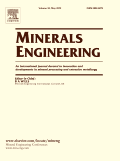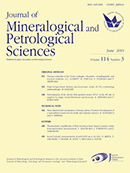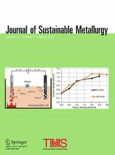
MINERALS ENGINEERING
Scope & Guideline
Exploring the Frontiers of Geotechnical Engineering
Introduction
Aims and Scopes
- Mineral Processing Techniques:
Exploration of various mineral processing methods such as flotation, leaching, magnetic separation, and bioleaching, aimed at optimizing recovery and efficiency. - Sustainable Mining Practices:
Research on environmentally friendly methods of mineral extraction and processing, including waste management and resource recycling, to promote sustainability in the mining industry. - Advanced Characterization and Modeling:
Utilization of advanced characterization techniques and computational modeling to understand mineral behavior and improve processing techniques. - Innovative Reagents and Collectors:
Development and testing of new reagents, collectors, and depressants for selective mineral separation processes. - Geometallurgy:
Integration of geological and metallurgical data to enhance the understanding of ore characteristics and improve processing outcomes. - Hydrometallurgy and Pyrometallurgy:
Studies on the extraction of metals through hydrometallurgical and pyrometallurgical methods, focusing on process optimization and recovery rates.
Trending and Emerging
- Sustainable and Green Technologies:
A growing emphasis on eco-friendly practices and sustainable technologies in mineral processing, including the development of biodegradable reagents and methods to minimize environmental impact. - Advanced Characterization Techniques:
Increased focus on advanced characterization methods such as X-ray micro-computed tomography and machine learning for ore analysis and flotation optimization. - Bioleaching and Bioremediation:
Rising interest in the use of biological processes for the extraction of metals and remediation of contaminated environments, reflecting a trend towards greener mining practices. - Multi-metal Recovery from Complex Ores:
An emerging trend towards the recovery of multiple metals from complex ore bodies, improving resource efficiency and reducing waste. - Machine Learning and AI Applications:
The integration of machine learning and artificial intelligence in mineral processing for predictive modeling, process optimization, and real-time monitoring. - Carbon Footprint Reduction Strategies:
Research focused on methods to reduce carbon emissions and enhance energy efficiency in mineral processing operations, aligning with global sustainability goals.
Declining or Waning
- Traditional Methods without Innovation:
There is a noticeable reduction in studies focused solely on traditional mineral processing methods without the incorporation of innovative technologies or sustainability practices. - Basic Comminution Studies:
Research centered on the fundamental aspects of comminution appears to be waning, possibly due to a shift towards more integrated and innovative approaches in mineral processing. - Conventional Solvent Extraction Techniques:
Studies focusing on conventional solvent extraction methods without advancements in reagent development or process optimization have decreased. - Single-Metal Extraction Processes:
Research focused on the extraction of single metals from ores, without considering the broader context of multi-metal recovery or environmental impact, has seen a decline.
Similar Journals

MINERALOGY AND PETROLOGY
Exploring the Depths of Earth's MaterialsMINERALOGY AND PETROLOGY, published by Springer Wien, is a premier academic journal that has been contributing to the fields of geochemistry, petrology, and geophysics since its inception in 1987. With an ISSN of 0930-0708 and an E-ISSN of 1438-1168, this journal is recognized for its rigorous peer-reviewed articles that advance the understanding of mineral and rock formation processes, their physical and chemical properties, and the implications for broader Earth sciences. Holding a respectable impact factor and categorized in the Q2 quartile for both Geochemistry and Petrology, as well as Geophysics, MINERALOGY AND PETROLOGY ranks favorably among its peers, placing it within the top 50% of scholarly publications in these fields. Researchers, professionals, and students alike will find a wealth of knowledge in its pages, as it serves as a valuable resource for those aiming to explore the complexities of Earth's materials and compositions. Although it does not offer an Open Access option, the journal assures high-quality, impactful research that is crucial for ongoing advancements in Earth sciences.

Periodico di Mineralogia
Bridging Research and Application in GeologyPeriodico di Mineralogia, published by SAPIENZA UNIV EDITRICE, is a distinguished academic journal based in Italy that has been pivotal in advancing the fields of Geochemistry, Geology, and Geophysics since its inception in 1979. With an ISSN of 0369-8963 and an E-ISSN of 2239-1002, the journal boasts a solid reputation reflected in its Q3 category rankings across these disciplines as per 2023 metrics. The journal’s scope encompasses a broad range of topics related to mineralogy and earth sciences, providing a vital platform for researchers, professionals, and students to disseminate their findings. Despite the absence of an Open Access option, Periodico di Mineralogia remains an essential resource for the dissemination of high-quality research that contributes to our understanding of earth processes and materials. Situated in the heart of Rome at PIAZZALE ALDO MORO 5, it serves as a crucial bridge between academic research and practical applications in geology and planetary sciences.

Minerals
Exploring the depths of geology and engineering innovation.Minerals, an esteemed open-access journal published by MDPI, has been at the forefront of advancing knowledge in the fields of geology, geotechnical engineering, and engineering geology since its inception in 2011. With an E-ISSN of 2075-163X, this journal aims to foster innovative research and disseminate critical findings that influence both academia and industry practices. Based in Switzerland, Minerals has made significant strides in its impact, evidenced by its 2023 Scopus rankings placing it in the 74th percentile in Geology and 63rd percentile in Geotechnical Engineering. The journal, which will continue to publish until 2024, encourages submissions that explore the multifaceted aspects of mineral sciences, highlighting the importance of sustainable practices and advancements in technology. Researchers, professionals, and students are invited to engage with this vital resource, which not only contributes to the expansion of geological knowledge but also supports the global understanding of mineral resources.

Bulletin of the Tomsk Polytechnic University-Geo Assets Engineering
Fostering Collaboration for Sustainable Geo Engineering PracticesBulletin of the Tomsk Polytechnic University-Geo Assets Engineering is a prestigious open-access journal published by the TOMSK POLYTECHNIC UNIV, PUBLISHING HOUSE, dedicated to advancing knowledge in the fields of economic geology, fuel technology, and geotechnical engineering among others. With an ISSN of 2500-1019 and an E-ISSN of 2413-1830, the journal has achieved a notable position in the academic landscape since its inception in 2015, as evidenced by its Q3 quartile rankings across various categories in 2023, including Environmental Science and Materials Science. This journal provides a vital platform for researchers and professionals to disseminate cutting-edge findings, contribute to innovative practices, and engage in meaningful discourse regarding geo assets and their management in the context of contemporary environmental challenges. While the journal continues to grow in impact, it remains accessible to a wider audience, promoting sustainability and responsible resource management. Researchers, industry experts, and students will find valuable insights and the latest developments relevant to these dynamic fields through its comprehensive and rigorous peer-reviewed articles.

Mining Metallurgy & Exploration
Bridging Disciplines in Mining and Metallurgical Sciences.Mining Metallurgy & Exploration is a prominent journal published by Springer Heidelberg, dedicated to the multidisciplinary fields of mining, metallurgy, and exploration. With an ISSN of 2524-3462 and an E-ISSN of 2524-3470, this journal is based in Switzerland and plays a critical role in disseminating innovative research and discoveries that advance the understanding and application of materials and processes in the mining and metallurgical industries. The journal boasts impressive Scopus rankings, positioning it in the second quartile (Q2) for Chemistry and Mechanical Engineering, and Q3 for Geotechnical Engineering and Control Systems Engineering, which underscores its significance and reach in these vital areas. Access to the journal is available under an Open Access model, ensuring that cutting-edge research is freely accessible to a global audience. Publishing quality research from 2019 to 2024, Mining Metallurgy & Exploration aims to foster cross-disciplinary collaboration, stimulate academic discourse, and serve as a vital resource for researchers, professionals, and students keen to engage with the latest advancements in the mining and metallurgical sciences.

JOURNAL OF MINING SCIENCE
Shaping the Future of Mining Science Through Cutting-Edge ResearchJOURNAL OF MINING SCIENCE, published by PLEIADES PUBLISHING INC, is a leading platform for research and development in the fields of geology, geotechnical engineering, and engineering geology. With an ISSN of 1062-7391 and E-ISSN of 1573-8736, this journal has established itself as a notable contributor to the mining and earth sciences communities since its inception in 1991. The journal is indexed in prestigious databases and currently holds a Q3 ranking in both geology and geotechnical engineering categories, recognizing the impact and quality of the research it publishes. Although it does not offer open access, it provides extensive insights from cutting-edge studies that appeal to researchers, professionals, and students alike. The Journal of Mining Science aims to disseminate significant advancements in mining technology and its environmental implications, promoting sustainability and innovation within the industry. With its comprehensive scope and commitment to excellence, this journal serves as an invaluable resource for stakeholders in academia and industry striving to enhance their knowledge and practices in mining science.

Applied Earth Science-Transactions of the Institutions of Mining and Metallurgy
Transforming Earth Science Discoveries into Industry SolutionsApplied Earth Science - Transactions of the Institutions of Mining and Metallurgy, published by SAGE Publications Inc, is a vital academic journal located in the United Kingdom that seeks to illuminate the intricate relationship between earth sciences and the mining and metallurgy industries. With an ISSN of 2572-6838 and an E-ISSN of 2572-6846, the journal features peer-reviewed research encompassing various subfields such as Geochemistry, Petrology, and Geotechnical Engineering. As an open-access journal, it ensures that cutting-edge findings are readily available, promoting broad access to knowledge crucial for professionals, researchers, and students alike. With its convergence of research years from 2018 to 2024, the journal maintains a Q3 ranking in Earth and Planetary Sciences and Q4 rankings in Geochemistry and Petrology as well as Geotechnical Engineering, which demonstrates its emerging influence in these disciplines. The journal not only provides a platform for innovative research but also addresses practical challenges faced within the field, making it essential reading for those engaged in the applied earth sciences.

Journal of Mineralogical and Petrological Sciences
Unveiling the Secrets of Geological ProcessesThe Journal of Mineralogical and Petrological Sciences, published by the Japan Association of Mineralogical Sciences, serves as a vital platform for disseminating high-quality research in the fields of mineralogy and petrology. With a presence in both traditional and digital formats (ISSN: 1345-6296; E-ISSN: 1349-3825), this journal fosters scholarly engagement and innovation within these crucial branches of Earth Sciences. As evidenced by its Q3 ranking in both Geology and Geophysics categories for 2023, Journal of Mineralogical and Petrological Sciences maintains a significant standing within the academic community, contributing to the ongoing discourse and exploration of mineralogical phenomena and processes. Researchers, professionals, and students alike will find valuable insights and advancements represented within its pages, with a commitment to inclusivity in research output spanning two decades (2000-2024). Although not currently open access, the journal remains a key resource for understanding the complexities of our geological world.

HYDROMETALLURGY
Pioneering innovations in hydrometallurgical processes.HYDROMETALLURGY is a premier journal dedicated to advancing the field of hydrometallurgical processes, published by Elsevier. Since its inception in 1975, it has become a vital resource for researchers and practitioners in the realms of industrial and manufacturing engineering, materials chemistry, and metallurgical science. With its impressive impact factor and ranking in the top quartiles of its categories, this journal consistently disseminates high-quality research and reviews that drive innovation in materials extraction and processing. The journal is essential for those involved in the development of sustainable metallurgical practices, sharing insights on cutting-edge techniques and applications in metal recovery and recycling. Although not an open access publication, HYDROMETALLURGY offers valuable access options, facilitating in-depth study and exploration of current advancements in the field. As it continues to bridge theoretical knowledge and practical application, researchers, professionals, and students alike are encouraged to contribute their findings and engage with the community.

Journal of Sustainable Metallurgy
Exploring the intersection of environment and engineering.Journal of Sustainable Metallurgy is a leading academic journal published by Springer, dedicated to advancing knowledge in the field of sustainable metallurgy and material sciences. With an ISSN of 2199-3823 and E-ISSN 2199-3831, this journal occupies a pivotal role in the intersection of Environmental Science, Materials Science, and Engineering, boasting a commendable impact factor and significant visibility in scholarly discussions. Operating under a Q2 category in 2023 across various rankings, including Environmental Science and Mechanics of Materials, it provides valuable insights for researchers, industry professionals, and students focusing on sustainable practices in metallurgy. The journal's aim is to disseminate high-quality research that addresses the technical challenges and innovations in material sustainability from 2015 to 2024. Through robust peer-review processes, it ensures the dissemination of rigorous research, fostering an informed dialogue within the global materials community. For those interested in open access options, please refer to the publisher's website for more information.